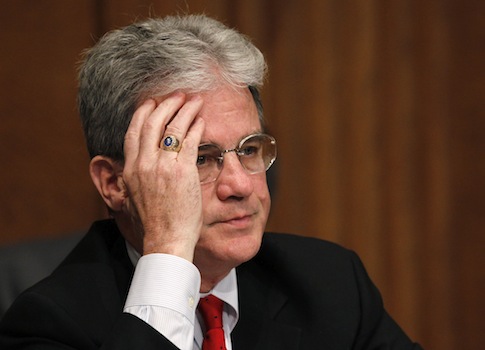Federal tax credits meant to stimulate the economies of low-income communities have gone to dog day cares, sculptures, recording studios, and breweries, according to a report released by Sen. Tom Coburn (R., Okla.).
Through the New Markets Tax Credit program, tax credits are sold to private investors for development projects in poor communities, amounting to approximately $1 billion in credits every year. The credits are intended to create jobs for poor areas.
However, due to the program’s overly broad definition of what qualifies as a "low-income community," nearly any city or town in the country is eligible. As a result, credits have been taken advantage of by Hollywood producers, Wall Street bankers, and major corporations, in what Coburn calls a "billionaire’s fantasy island."
"The New Market Tax Credit is a reverse Robin Hood scheme paid for with the taxes collected from working Americans to provide pay outs to big banks and corporations in the hope that those it took the money from might benefit," Dr. Coburn said in a statement. "When government picks winners and losers, the losers usually end up being taxpayers."
"Washington should reduce federal taxes on working Americans and all business owners who create jobs by eliminating tax earmarks, loopholes, and giveaways like the New Markets Tax Credit," he said.
Coburn’s report revealed that the tax credit has subsidized almost 4,000 projects, including limousine services, eBay consignment selling services, churches, doggie day care and a dog grooming facility.
"Many of these are wasteful and not a federal priority—such as an ice skating rink and a car museum—while others are corporations in little need of taxpayers’ handouts—such as chain restaurants like Subway and IHOP," the report said.
Some projects are ineligible to receive credits. For instance, the NMTC cannot finance hot tub facilities, golf courses and country clubs, or tanning salons.
The credit does finance wellness centers, including one in California that is "threatening to bankrupt the city" of Desert Hot Springs.
The wellness center was designed to provide health and dental care to low-income residents of the area, but is running a deficit in the already cash-strapped town.
"The city cannot sustain the center, according to a financial analysis released in July 2014 by ‘a state-appointed employment arbitration panel,’" the report said. "As a result, the city may be forced to increase user fees or reduce services at the Wellness Center."
The center also spent $65,000 of NMTC financing on a sculpture entitled, "Dancing on the Wind," that features two figures "reaching toward the heavens."
"This major art piece that we have here signifies where we want to go," Desert Hot Springs Mayor Adam Sanchez said of the artwork. "It’s all about health and wellness."
According to the Government Accountability Office (GAO) the tax credit results in hundreds of millions of dollars in lost revenue each year. Coburn questioned whether the program, which originated in the Community Renewal Tax Relief Act, bipartisan legislation passed in 2000, should be extended.
The NMTC was renewed in 2010, making $33 billion available in credits. The credits were again reauthorized in 2012, though a $3.5 billion limit per year for 2012 and 2013 was placed on the program. The Senate Finance Committee passed an additional extension of the program in April in legislation entitled, "The EXPIRE Act." The bill is awaiting action in the Senate.
Coburn’s report argues that in addition to financing wasteful projects, the program is also redundant, because it "duplicates over 100 other federal economic development efforts." The report cites 23 other similar tax credits that cost more than $10 billion a year, and 80 other overlapping programs that cost $6.5 billion.
"The report is not intended to demonize the entities receiving the funds or the projects they are supporting, but rather to provide some transparency for taxpayers to decide whether the program should be continued or ended," Coburn wrote. "If Congress allows it to expire, taxpayers could save $1 billion a year."
